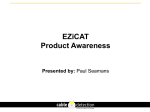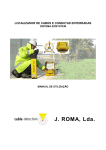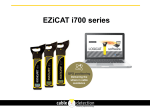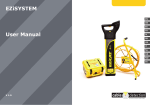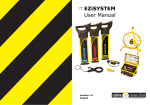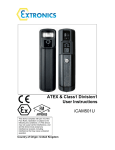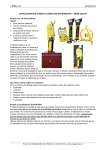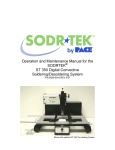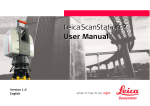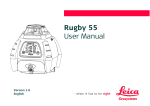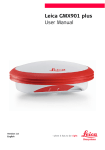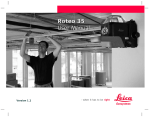Download Cable Locator User Manual
Transcript
EziSYSTEM User Manual Version 1.0 English Introduction EziSYSTEM 2 Introduction Purchase Congratulations on your purchase of an EziSYSTEM instrument. This manual contains important safety directions as well as instructions for operating the product. Refer to "9 Safety Directions" for further information. Read carefully through the User Manual before you switch on the product. Product identification The model and the serial number of your product are indicated on the type plate. Enter the model and serial number in your manual and always refer to this information when you need to contact your agency or cable detection authorized service workshop. Type: _________________________ Serial No.: _________________________ Symbols The symbols used in this manual have the following meanings: Type Danger Warning Caution ) Trademarks Introduction Description Indicates an imminently hazardous situation which, if not avoided, will result in death or serious injury. Indicates a potentially hazardous situation or an unintended use which, if not avoided, could result in death or serious injury. Indicates a potentially hazardous situation or an unintended use which, if not avoided, may result in minor or moderate injury and/or appreciable material, financial and environmental damage. Important paragraphs which must be adhered to in practice as they enable the product to be used in a technically correct and efficient manner. EziCAT, EziTRACE and EziROD are registerd trademarks of Cable Detection Ltd. All other trademarks are the property of their respective owners. EziSYSTEM 3 Table of Contents EziSYSTEM 4 Table of Contents In this manual Chapter Page 1 How to Use this Manual 7 2 General Information 8 3 How the EziSYSTEM Functions 10 3.1 3.2 3.3 3.4 3.5 3.6 3.7 10 11 13 14 15 15 16 4 5 EziSYSTEM EziCAT EziTRACE EziROD SIGNAL CLAMP PROPERTY CONNECTION SET Sonde Basic Overview 17 4.1 4.2 4.3 4.4 17 21 23 24 EziCAT Overview EziTRACE Overview EziROD Overview Best Practise Procedure Tracing Modes Summary 28 5.1 5.2 28 30 30 31 33 34 5.3 EziCAT Tracing Modes EziTRACE Tracing Modes 5.2.1 General 5.2.2 Connection Mode 5.2.3 Induction Mode EziROD Tracing Modes 6 7 8 9 Table of Contents How to Use the EziCAT 37 6.1 6.2 6.3 6.4 6.5 37 39 42 46 49 EziCAT Start Up Test Locating Process Depth measurement EziCAT Locating With the EziTRACE Locating the Sonde With an EziCAT How to Use the EziTRACE 52 7.1 7.2 7.3 52 53 56 EziTRACE Start Up Test How to Use the EziTRACE With an EziCAT How to Use the EziTRACE With an EziROD And an EziCAT Care and Transport 57 8.1 8.2 8.3 57 57 58 Transport Storage Cleaning and Drying Safety Directions 59 9.1 9.2 9.3 9.4 9.5 9.6 9.7 9.8 59 59 60 60 61 61 66 68 General Purpose Limits of Use Areas of Responsibilities International Warranty Hazards of Use Electromagnetic Compatibility EMC FCC Statement, Applicable in U.S. EziSYSTEM 5 Table of Contents EziSYSTEM 10 Technical Data 72 10.1 10.2 10.3 EziCAT Technical Data EziTRACE Technical Data EziROD Technical Data 72 76 79 Functional Checks 81 EziCAT Functional Check EziTRACE Functional Check EziROD Functional Check 81 87 92 Appendix A A.1 A.2 A.3 Index 6 95 1 How to Use this Manual ) It is recommended to set up the product while reading through this manual. Naming convention EziCATTM100, EziCATTM200 Is hereinafter referred to as EziCAT. Differences between the two models are marked and described. General pictures show a EziCAT 200 instrument. EziTRACETM Is hereinafter referred to as EziTRACE. EziRODTM Is hereinafter referred to as EziROD. Validity of this manual This manual applies to all EziSYSTEM instruments, which are EziCAT 100, EziCAT 200, EziTRACE and EziROD. Differences between the various instruments and models are marked and described. Index The index is at the back of the manual. Instrument label On the EziCAT and the EziTRACE instrument you will find a label that shows some important information by means of illustrations. You will find some of these illustrations in this manual too. This should help to get a clear connection between the instrument label and the information in this manual. How to Use this Manual EziSYSTEM 7 General Information 8 EziSYSTEM 2 General Information Many services are buried underground Why do we require Underground Service Location Systems ? This is Why! ? Highway ? ? ? Highway ? Gas Why we detect and locate services • • • To repair them To avoid (damaging) them To document them High and Low Voltage Electricity Surface Water Drain Foul Sewer Drain How we detect and locate services • Using Plans and drawings: Drawings, plans or information should always be obtained but they may be inaccurate or incomplete. The difficulty of obtaining information about buried utility lines is that nothing is visible. • Electromagnetic location: This method of locating buried pipes, cables and sewers has become almost universal. The main shortcoming is that it will not locate non-metallic services such as plastic pipes. However, utilities taking the small amount of trouble to lay tracer wires with plastic pipes are not affected by this shortcoming, additionally the use of an accessory such as a sonde can be used to overcome these shortcomings. The technology has a large number of advantages and cable detection specialize in developing and exploiting electromagnetic location technology. ) General Information Although the EziSYSTEM consits of a wide range of powerful tools, it is vital to obtain diagrams, drawings and other information about the area to be traced. EziSYSTEM 9 How the EziSYSTEM Functions 10 EziSYSTEM 3 How the EziSYSTEM Functions 3.1 EziSYSTEM General information The EziSYSTEM is a collection of products used to locate buried metallic and nonmetallic services. EziSYSTEM Instruments a b a) EziCAT 100 Service Locator b) EziCAT 200 Service Locator c) EziTRACE Signal Generator Accessories c a a) b) c) d) b c EziROD non metallic service tracer Property Connection Set Signal Clamp Sonde d 3.2 EziCAT General information The EziCAT is designed to work in conjunction with the EziTRACE signal generator. It is also compatible for use with any other signal generator that operates with a constant signal output at the same frequency (8 or 33 kHz). Operating modes • • • Electromagnetic signals The EziCAT locator detects the electromagnetic field, which is emitted by electrical currents passing through metallic underground services. The EziCAT converts the electromagnetic field into an electrical signal, which then informs the user of the results of the detection via the display panel. Passive signals Some signals are already present on buried services and can be readily detected by the EziCAT. We call these passive signals. These signals are generated by power distribution systems and radio transmitters. Active tracing Some metallic underground services do not emit passive signals. These services may be traced by applying a signal to the service using an EziTRACE. Depth measurement Depth measurement is only available with EziCAT 200 used in conjunction with the EziTRACE signal generator! Easy to use The EziCAT has been designed to be very user friendly. It is simple to use in many tracing situations without requiring highly trained operators. How the EziSYSTEM Functions Passive detection of power and radio signals radiated from most metallic services. Active detection of 8 or 33 kHz signals, in conjunction with EziTRACE signal generator. Depth indication is only available in 33 kHz generator mode and only with the EziCAT 200 used in conjunction with an EziTRACE signal generator. EziSYSTEM 11 How the EziSYSTEM Functions Function check EziSYSTEM 12 This is done to ensure the EziCAT and EziTRACE are functioning correctly and are operating at the same frequency. 1. Switch on the EziTRACE, select the required frequency and verify the mode and output displays. 2. Ensure that the EziTRACE is in Induction mode; there should not be a plug in the connection socket. 3. Power up the EziCAT and select the same frequency at which the EziTRACE is operating. 4. Bring the EziCAT to within two metres of the EziTRACE. The central bar display on the EziCAT should indicate an output from the EziTRACE. 3.3 EziTRACE Tracing signal The EziTRACE applies an electrical current signal onto a buried metallic service, which enables the service to be traced and identified by an EziCAT locator operating in the same mode. Operating mode There are two operating modes enabling the user to select for the best results on site: • 8 kHz for congested site operation or • 33 kHz for general usage and for depth reading in conjunction with EziCAT 200. When operated in the connection mode both 8 and 33 kHz signals can be applied together so that rapid selection and convenience the best results can be simply achieved by changing the EziCAT locator mode. Direct connection Using the supplied leads, the tracing signal can be applied directly to a service resulting in better coupling to the service and reduced cross coupling to any nearby services. Induction An internal induction antenna provides convenient non contact means of applying the tracing signal to an inaccessible or electrically live metallic service. Accessories EziTRACE accessories provide alternative means for non contact, direct application of the tracing signal to a range of buried metallic services or for tracing non metallic services such as plastic or concrete sewer pipes. Easy to use The EziTRACE has been designed to be very user friendly, it is simple to use with default operation of the most commonly used 33 kHz induction mode operation and set to maximum output signal strength. Function check Refer to "Function check" in "3.2 EziCAT". How the EziSYSTEM Functions EziSYSTEM 13 How the EziSYSTEM Functions EziSYSTEM 14 3.4 EziROD General information The EziROD is the non metallic service tracer of the EziSYSTEM for small diameter pipes and ducts. This accessory is connected to the EziTRACE, and can be used for tracing non metallic pipes and conduits in two modes: • line mode where a signal is applied to the length of the EziROD, and • sonde mode where just the tip emits the signal. Operates at 8 and 33 kHz modes. Tracing signal The rod is inserted and then pushed into the pipe, duct, conduit or drain (and thus uncoiled from the reel) until the desired length is in place. The EziTRACE is then connected using the EziROD connection lead and the 8 or 33 kHz tracing signal is then available either only at the end of coil sonde or along the whole length of the coil. 3.5 SIGNAL CLAMP General information Designed to enable the EziTRACE’s signal to be applied to any metallic services, for example pipes, insulated electricity cables. The signal clamp is clipped over the pipe or electricity cable, and attached to the EziTRACE. Supply is not interrupted by the applied signal and the operator is not exposed to any live services. Operates at 8 and 33 kHz modes. Danger A hazardous signal may be present on the connection plug of the signal clamp when clipped over a live service. Precautions: The clamp should be connected to the EziTRACE before clamping around a live service. 3.6 PROPERTY CONNECTION SET General information For use with the EziCAT and the EziTRACE it allows the connection of a signal to any internal power distribution system for tracing cabling throughout the property. It is also useful for locating where the main electricity supply enters a property. Allows a tracing signal to be applied to a power distribution system for tracing the electricity supply outside the property. Operates at 8 and 33 kHz modes. How the EziSYSTEM Functions EziSYSTEM 15 How the EziSYSTEM Functions EziSYSTEM 16 3.7 Sonde General information The Sonde is the non metallic service tracer of the EziSYSTEM for large diameter sewer and other non metallic pipes. Operating from a single AA sized battery this is a self contained transmitter and is used in conjunction with standard drain rods to propel it along the pipe. It is then traced using the EziCAT. Operates at 33 kHz mode. 4 Basic Overview 4.1 EziCAT Overview EziCAT Controls and features a b c d e f Basic Overview EziSYSTEM a) Display Panel Contains the operational controls. b) Speakers (left and right) Active when a signal is detected. A port for an optional stethoscope headphone is provided over each speaker. c) On/Off Trigger Pressing and holding the trigger activates the EziCAT. d) Battery Hatch Release Pressing the yellow release button unlocks the Battery Hatch allowing access to the battery compartment. e) Battery Compartment 6 x LR6 (AA) alkaline batteries are used. Replace all batteries once the battery pack becomes exhausted. f) Case Foot This component can be replaced if it is worn. 17 Basic Overview 18 EziSYSTEM EziCAT 200 display panel and controls a d e f b g c a) Battery indicator Flashes when approximately 20% of battery life remains. The rate of flashing increases as the battery life declines. b) Mode indicators Displays the selected mode Power, Radio, 8 kHz, 33 kHz (as shown, from bottom to top). c) Function control Selects EziCAT operating mode. d) Bar display Indicates the response of the EziCAT to a signal. e) Depth modes indicator Light to show whether the EziCAT is measuring depth in line or sonde mode. f) Numerical display Shows the depth to the source of the signal (line or sonde) when in depth mode; displayed in metric or ft / inch units depending on the model. Refer to "6 How to Use the EziCAT" for a full explanation. g) Depth modes To estimate the depth of a service, the button should be pressed once for line mode or pressed and held for sonde mode. Depth measurement only functions with the EziCAT switched to 33 kHz and used in conjunction with a EziTRACE (line) or a sonde. EziCAT 100 display panel and controls a d a) Battery indicator Flashes when approximately 20% of battery life remains. The rate of flashing increases as the battery life declines. b) Mode indicators Displays the selected mode Power, Radio, 8 kHz, 33 kHz (as shown, from bottom to top). c) Function control Selects EziCAT operating mode. d) Bar display Indicates the response of the EziCAT to a signal. b c Basic Overview EziSYSTEM 19 Basic Overview Change battery 20 EziSYSTEM 1. Battery indicator flashes when approximately 20% of battery life remains. The rate of flashing increases as the battery life declines. 2. Press the yellow release button to unlock the Battery Hatch. Remove the battery compartment from the EziCAT. 3. Replace all batteries with six new LR6 (AA) batteries. Alkaline batteries should be used. ) 4.2 EziTRACE Overview EziTRACE Controls and features a Basic Overview b c d e f g h i EziSYSTEM j a) Accessory Cover b) Battery Cover c) Power Control Pressing this button toggles the EziTRACE on and off. d) Mute Control Used to silence the EziTRACE speaker. e) Mode Display Indicates which mode is selected - induction or connection. f) Frequency Control Used to select 8 kHz or 33 kHz output g) Frequency Display Indicates which frequency is selected 8 kHz or 33 kHz. h) Level Control Used to vary the signal output of the EziTRACE. i) Level Meter Display Indicates either the battery level or the signal level. j) Connection Socket Used to connect accessories directly to metallic services (standard: crocodile clip cable set, optional: EziROD, Signal Clamp, property connection cable set). 21 Basic Overview 22 EziSYSTEM Change battery 1. Battery indicator flashes when approximately 20% of battery life remains. The rate of flashing increases as the battery life declines. 2. Loosen the two screws of the battery cover and remove them together with the cover. 3. Replace all batteries with four new LR14 (C) batteries. Alkaline batteries should be used. 4x LR14 (C) 2 1 ) 4.3 EziROD Controls and Features EziROD Overview a a) End of Coil - Sonde or Mouse Used to accurately pinpoint the end point of the rod. b c b) Coil, mounted on a reel Flexible, Glass Fibre Sheathed, Copper Conductor Coil, which incorporates copper wires to conduct the signal. c) Signal connection socket Used to connect to the EziTRACE (or other Transmitter). d d) Frame Houses the flexible coil – can be used in both vertical (shown) and horizontal orientation. The rod is inserted and then pushed into the pipe, duct, conduit or drain (and thus uncoiled from the reel) until the desired length is in place. The EziTRACE is then connected to the signal connector and the tracing signal is then available either only at the end of coil sonde or along the whole length of the coil. Refer to "5.3 EziROD Tracing Modes" for information on how to select the required mode. Basic Overview EziSYSTEM 23 Basic Overview EziSYSTEM 4.4 Best Practise Procedure Using EziCAT, EziTRACE and EziROD The following is a suggested best practise procedure for using the EziCAT, EziTRACE and EziROD. 24 Examine the area for evidence of recently installed services. Obtain Utility drawings and other relevant information (if available). Mark out the area to be surveyed / excavated. Make sure you - and all other users - are fully conversant with the EziCAT, the EziTRACE and the EziROD and all their functions. With the EziCAT conduct a sweep search within the marked area in power mode followed by radio mode. Get to know the EziCAT. Ensure the EziCAT and the EziTRACE are functioning correctly and are regularly serviced. Practise over known underground services. Thoroughly sweep the area in both power and radio modes. Use the EziCAT and EziTRACE in co-operation whenever possible. Use the EziCAT in the trench to check for further underground services after excavating approx. 0.3 m / 1 ft. ) The depth function is only available in 33 kHz generator mode and only with the EziCAT 200 used in conjunction with an EziTRACE signal generator. Typical use cases EziCAT use with EziTRACE in Connection mode: Attach the Clip on the red cable to the metallic service. Attach the clip on the black cable to earth stake positioned at right angles and as far as possible from the service to be traced. Set both EziTRACE and EziCAT to 33 kHz mode and use the EziCAT to trace the service. For details see "5 Tracing Modes Summary". Warning Basic Overview Connecting the lead set to a live service can result in receiving an electric shock. Precautions: The connection lead set should never be connected directly to a live service. EziSYSTEM 25 Basic Overview EziSYSTEM 26 EziCAT use with EziTRACE and EziROD: Connet the EziTRACE to the EziROD and also to earth stake as shown. Inserted and push the rod into the service to be traced. Set both EziTRACE and EziCAT to 33 kHz mode and use the EziCAT to trace the signal and therefore the service along the full length of the EziROD wire. For details see "5 Tracing Modes Summary". Caution Basic Overview The absence of a positive indication does not guarantee the non-existence of a service. Services without a detectable signal may be present. The EziCAT can only locate non-metallic services such as plastic pipes, typically used by the water and gas utilities, with the use of appropriate accessories. Precautions: Always excavate with care. EziSYSTEM 27 Tracing Modes Summary EziSYSTEM 28 5 Tracing Modes Summary 5.1 EziCAT Tracing Modes Available operation modes The EziCAT operates in the following modes: • Power mode (= default mode) • Radio mode • 8 kHz mode • 33 kHz mode Power mode Frequency range: 50 Hz - 1.5 kHz This is a passive mode – the signal, which the EziCAT detects, is already present on the service. Used to trace live (energised) electrical power cables with sufficient current flow. Other services may emit power signals due to currents flowing in them, such as metallic water pipes. Radio mode Frequency range: 15 kHz - 30 kHz This is a passive mode – the signal, which the EziCAT detects, is already present on the buried service. Used to trace metallic services, which may or may not have a power signal present. The radio signal originates from powerful transmitters, operating at frequencies detectable by the EziCAT. 8 kHz mode Frequency range: 8192 ± 30 Hz This is an active mode – the signal, which the EziCAT detects, must be applied onto the service by an EziTRACE. Used to trace and identify metallic services, by impressing a distinct signal onto the service, allowing it to be traced above ground. The 8 kHz signal provides minimum cross coupling (leakage of signal from one service to another), when tracing in congested areas where many services are present. 33 kHz mode Frequency range: 32768 ± 30 Hz This is an active mode – the signal, which the EziCAT detects, must be applied onto the service by a EziTRACE. Used to trace and identify metallic services, by applying a distinct signal onto the service, allowing it to be traced above ground. The 33 kHz signal provides a greater locating interference rejection for example increased coupling capability, than 8 kHz, but with increased cross coupling (leakage of signal from one service to another). Depth measurements Only available with EziCAT 200 operable in 33 kHz only. When the depth function button is pressed and released, line mode is selected and will display the depth to the centre of the line being traced. If a sonde is being used, the button should be pressed and held, this will display the depth to the sonde. The depth reading is displayed for five seconds. Tracing Modes Summary EziSYSTEM 29 Tracing Modes Summary EziSYSTEM 5.2 EziTRACE Tracing Modes 5.2.1 General Available operation modes The EziTRACE operates in the following modes: 30 • Connection Mode • Crocodile Clip Cable Set • Property Connection Cable Set • EziROD cable Set EziROD Modes: EziROD End of Coil Sonde Mode, EziROD Whole Coil Mode, Induction Mode • EziTRACE induction mode • Placed overhead and in line with an buried service Output signal frequency • • Connection mode: output 8 or 33 kHz or both signals combined Induction mode: output 8 or 33 kHz 5.2.2 Connection Mode ) Always use connection mode if possible. General Used to allow EziCAT to identify and trace underground metallic services, including those which have no power or radio signals present, by impressing a specific signal generated by the EziTRACE, which is unlike other power and radio signals, via a connection accessory cable set (specific to the application under consideration). Other types of services, such as concrete pipe, plastic duct, can be traced in conjunction with the use of an additional tool, the EziROD. Plug the required cable set into the connection socket of the EziTRACE, the connection light will illuminate and a low-pitched pulsing tone will be audible. The level meter will display the signal output flowing from the connection socket. Connect the accessory as required. The audible tone will change from pulsed to continuous when a good connection is made. Types of Connection cable sets Warning 1. Crocodile Clip Cable Set (with red and black cables) Attach the Clip on the red cable to the metallic service. Attach the clip on the black cable to earth stake positioned at right angles and as far as possible from the service to be traced. Connecting the lead set to a live service can result in receiving an electric shock. Precautions: The connection lead set should never be connected directly to a live service. 2. Property Connection Cable Set SAFE TO USE ON LIVE ELECTRIC SOCKETS. Plug into an energised electricity socket - ensure the socket is switched on. Generated signal from the EziTRACE will be impressed upon all wiring within, and leading to, the property. Tracing Modes Summary EziSYSTEM 31 Tracing Modes Summary EziSYSTEM 32 3. Signal Clamp SAFE TO USE ON LIVE ELECTRIC CABLES. Open the signal clamp – place around the service under investigation. Generated signal from the EziTRACE will be impressed upon the service investigation. Danger A hazardous signal may be present on the connection plug of the signal clamp when clipped over a live service. Precautions: The clamp should be connected to the EziTRACE before clamping around a live service. 4. EziROD For use in tracing non-metallic services such as clay, plastic, concrete, wooden pipes, ducts, conduits. This accessory comes with it’s own cable set. Please refer also to the instructions in "5.3 EziROD Tracing Modes". 5.2.3 Induction Mode ) When turned on in induction mode the EziTRACE is set to 33 kHz mode and maximum output power. General Used when connection mode is not possible or convenient, by magnetically inducing a specific signal generated by the EziTRACE into a underground metallic service. Position the EziTRACE over the underground metallic service so that the direction arrows on the lid of the case are in alignment with the direction of the service. Remove any connected accessories from the output socket and select the operating mode ) Tracing Modes Summary When Induction mode is used in close proximity to other underground metallic services, separated by less than 2x burial depth, the induction signal may additionally couple into these services and result in a reduced performance locate and depth reading (EziCAT 200 only). EziSYSTEM 33 Tracing Modes Summary EziSYSTEM 34 5.3 EziROD Tracing Modes EziROD End of Coil Sonde Mode When the cable set connecting the EziROD and the EziTRACE is connected as shown below only the sonde on the end of the coil emits the locating signal, thus this specific point can be located (e.g. blockage in a pipe). 1. To EziTRACE connection socket 2. To EziROD connection socket 2 1 EziROD Whole Coil Mode When the cable set connecting the EziROD and the EziTRACE are connected as shown below the whole length of the coil can be traced (e.g. the route of a duct). 1. To EziTRACE connection socket 2. To EziROD connection socket 3. Connected to the EziTRACE earth spike, which is pushed into the ground. 3 2 1 ) Induction Mode Tracing Modes Summary It is normal for the EziTRACE to continue giving the pulsed tone when connected in this mode. Used to allow the EziCAT to identify and trace those underground metallic services, which have no power or radio signals present, by impressing a specific signal, which is unlike other power and radio signals. Position the EziTRACE over the buried service, with the arrows on the lid of the case aligned with the direction of the service. Switch on and 33 kHz (default) signal will be generated and transmitted. The transmitted signal will penetrate the surrounding environment and any EziSYSTEM 35 Tracing Modes Summary EziSYSTEM 36 metallic conductor intersecting the electromagnetic field will have an AC current "INDUCED" in it. The metallic service will then re-radiate its own 33 kHz signal, and it is this that the EziCAT detects and locates. EziTRACE 8 kHz mode Frequency range: 8192 ± 8 Hz This mode is most useful when tracing in areas where many services are present as it provides the minimum cross coupling (leakage of signal from one service to another). EziTRACE 33 kHz mode Frequency range: 32768 ± 30 Hz This mode is most useful when tracing in areas where a single service is to be traced for a considerable distance as it provides a far better tracing range than 8 kHz but with increased cross coupling (leakage of signal from one service to another) potential. 33 kHz mode is also required to obtain depth measurements with EziCAT 200. EziTRACE combined 8 and 33 kHz mode Frequency range: 32768 ± 30 Hz and 8192 ± 8 Hz This mode is available in connection mode only, it is most useful when tracing in variable site congestion conditions and from time to time either signal may give the best results. The EziCAT mode can be simply changed without returning to change the signal output from the EziTRACE. 6 How to Use the EziCAT 6.1 EziCAT Start Up Test Start up test This is best done in an area free of underground services. Hold the EziCAT vertically upright, press and hold the yellow on/off trigger. The following test sequence will take place. EziCAT 200 How to Use the EziCAT ON Test Test pattern Audio output On throughout test sequence LED bar display LEDs scroll through in sequence (once) Mode selection indicator LEDs scroll through in sequence Depth indicator LEDs scroll through test pattern. Depth LED's come on together "888". Battery low indicator On throughout test sequence. Flashes when batteries are low. Software version Depth indicator LED's displays current software version number EziSYSTEM Information on instrument label NONE 37 How to Use the EziCAT EziSYSTEM 38 EziCAT 100 ON Test Test pattern Audio output On throughout test sequence LED bar display LEDs scroll through in sequence (once) Mode selection indicator LEDs scroll through in sequence Battery low indicator On throughout test sequence. Flashes when batteries are low. Information on instrument label 6.2 Locating Process General The locating process is split into three steps: • Sweep search • Pinpointing • Direction These steps are described in detail on the following pages. Sweep search 2 4 2 + 4 Step ) How to Use the EziCAT Description The unit will automatically select Power mode and maximum sensitivity. 1. Mark out the area to be excavated with line marker or chalk. 2. Walk into the area in which you wish to search for underground services. Sweep across the area in a regular grid pattern with the EziCAT taking care not to swing it - i.e. keep it vertically upright and perpendicular to the ground. EziSYSTEM 39 How to Use the EziCAT 40 EziSYSTEM Step ) Description Ensure that the EziCAT is held in an upright position, and as close to the ground as possible. 3. Continue the sweep until either a signal is located or you are satisfied that the area has been adequately tested in power mode. 4. Repeat sweep in radio mode. ) Pinpointing with EziCAT In the presence of a signal indicating a buried service a tone will be emitted and the LED bar display will rise and fall as you pass over it. Move backwards and forwards over the service until the highest signal reading (peak response) is located. The service is directly below the EziCAT when the LED bar display is at its maximum reading. The EziCAT audio signal will automatically adjust to facilitate pinpointing over the service. ) ) The LED bar display does not indicate the size, depth or signal strength of a service. Always use chalk or paint to mark services, never pegs. Direction 1. To find the direction of a pinpointed service, position the EziCAT directly over the service. 2. Rotate the EziCAT on it's axis until the LED bar display drops to a minimum. 3. The LED bar is now in line with the service. ) Radio mode How to Use the EziCAT After a sweep in Power mode, a second sweep/pinpoint in radio mode should be undertaken, thereby maximising the detection process. Once the area has been swept in power mode, it should be swept again in radio mode. Metallic services running through the excavation site with insufficient or no power signal will not be located in power mode, but can represent a considerable risk if not identified before excavation starts. These services may be re-radiating radio signals which flow through the ground. When this happens a field is generated which can be detected up by the EziCAT in radio mode. EziSYSTEM 41 How to Use the EziCAT 6.3 42 EziSYSTEM Depth measurement Depth measurement, only with EziCAT 200 1. Hold the EziCAT over a line and at 90 degrees to the direction of the service to which an active 33 kHz signal has been applied (see chapter "Direction"). 2. Select 33 kHz mode. 3. Press and release the depth button for line depth. 4. The display LEDs will indicate the depth. The depth indication is displayed for five seconds. With the EziCAT over a sonde or EziROD and in line with the direction of the service press and hold the depth button. ) ) Depth measurement is available only in 33 kHz mode. The depth to the centre of the service will be displayed - in metric or ft / inch units depending on the model. d1 d2 d1 Depth shown on the EziCAT = depth to the centre of the line. d2 Actual depth of the service. Take special care when the signal is produced by a sonde, lying in a large diameter conduit! Note the difference between d1 and d2 ! Warning How to Use the EziCAT The depth reading might not reflect the real depth if your EziCAT picks up the signal induced into the service by the EziTRACE. This signal is radiated from the centre of the service. This is even more important when the signal is produced by a sonde, lying in a large diameter conduit! Precautions: Always compensate depth reading for service size. EziSYSTEM 43 How to Use the EziCAT Special information codes for depth measurement, only with EziCAT 200 EziSYSTEM Information code Description The service is too shallow to register properly. The service is too deep. The signal received by the EziCAT is too small to register properly. 44 Information on instrument label Information code Description Information on instrument label The signal received by the EziCAT is too large to register properly. Depth function not available. The EziCAT is set to the wrong mode for a depth reading to be taken. How to Use the EziCAT EziSYSTEM 45 How to Use the EziCAT EziSYSTEM 46 6.4 EziCAT Locating With the EziTRACE EziTRACE modes There are two EziTRACE modes, both of which are available in 8 or 33 kHz: • Induction • Connection. Induction mode The advantages of using induction mode are that it is quick and simple to use, and a signal can be applied to a service without having to make any physical connection to it. The disadvantages are that the risk of cross coupling (the signal applying itself to more than one service) to adjacent services is high, and part of the signal strength is lost in the surrounding soil. 33 kHz provides the best coupling efficiency. ) To induce a signal into a service, place the EziTRACE over the service, with the arrows on the top of the case pointing in the direction you believe the service is running, and turn it on. The service can now be traced by the EziCAT, providing EziCAT and EziTRACE are both set to the same frequency (8 or 33 kHz). Connection mode This is the most efficient way of applying a signal to a service, and should be used whenever possible. It is also the mode needed when any of the EziSYSTEM accessories are used. Connecting to a service The connection lead should be plugged into the EziTRACE, the earth spike pushed into the ground as far as possible from the EziTRACE, and at 90 degrees to the service to be traced. Next the red lead is attached to the service, and the black lead attached to the earth spike, ensuring the connections are as good as possible. The EziTRACE audio tone will change from pulsed to continuous when a good connection is made. If this does not occur, it may be necessary to clean connection points with a wire brush or sandpaper or improve the earth spike ground connection. Pour water over earth spike if operating with dry soil conditions to improve connection. The service can now be traced by the EziCAT, providing both EziCAT and EziTRACE are both set to the same frequency (8, 33 or 8 and 33 kHz combined). Danger Connecting the lead set to a live service can result in receiving an electric shock. Precautions: The connection lead set should never be connected directly to a live service. Using accessories The Signal Clamp, Property Connection set and EziROD are all used with the EziTRACE in Connection mode. The service can now be traced by the EziCAT, providing EziCAT and EziTRACE are both set to the same frequency (8, 33 or 8 and 33 kHz combined). Signal clamp Where it is not possible or unsafe to make a direct connection to the core of a target cable, (such as live power or telecom cables) the signal clamp may be clipped around the outer sheath. Property connection set (PCS) The PCS is plugged into a live electricity mains cable within the property, (preferably as close to the consumer unit as possible) and the other connector plugged into the EziTRACE. The EziTRACE and EziCAT, set to the same operating mode (8 or 33 kHz), can now be used to trace the electricity cable away from the property. EziROD This accessory has two modes of it's own: line and sonde. Line mode has the EziTRACE signal radiated along it's entire length, while sonde mode emits a signal only at the tip. Connect to the EziTRACE and set the EziTRACE to 8, 33 or 8 and 33 kHz combined mode. Set the EziCAT to the same operating freuqency. How to Use the EziCAT EziSYSTEM 47 How to Use the EziCAT EziSYSTEM 48 In line mode, the EziROD can be located like any other metallic service signal source. In sonde mode it is similar to the sonde, and can be located as per the instructions in the following pages. ) Depth estimation is only available with EziCAT 200 and in 33 kHz mode and will become inaccurate within 5 m / 16 ft of the tip! 6.5 Locating the Sonde With an EziCAT The difference between Lines and Sondes It is important to understand the difference between the signal emitted by a line (service) and that emitted by a sonde. A line emits a signal that is unsurprisingly linear, whereas a sonde emits a signal from a single point. Put simply, if these signals could be seen, then that of a line would appear as a long and large tube, that of a sonde as a giant donut (with the sonde located through the hole!). The procedure for locating a sonde The sonde radiates a peak signal with a "ghost" signal at each end of the peak. This locating procedure relies on pinpointing the null point between the ghost signal and the peak signal. Step 1: Start tracing by walking in a straight line through the area you suspect the sonde to be in (=pass 1). When you locate a three peaks signal with a null point between each, carefully mark the null points. Take one pace sideways and repeat this (=pass 2). How to Use the EziCAT EziSYSTEM 1.Pass 2.Pass 49 How to Use the EziCAT 50 EziSYSTEM Step 2: Turn the EziCAT through 90 degrees, and trace between the first null points of each pass in step 1. Step 3: Now trace between the second null points of each pass in step 1. In both cases a noticable dip in signal will be observed. The position of these points should be marked. The sonde is located at the midpoint of these. Step 4: Only with EziCAT 200: Position the EziCAT 200 directly overhead and in line with the sonde position. Press and hold the depth key, the sonde depth LED and reading will be displayed. 1.Pass 2.Pass ) How to Use the EziCAT If a "walk through" sewer is being traced, another method is to place the sonde vertically, for example to pinpoint a buried manhole. The EziCAT will pick up a pool of signal with a null point at the centre. This is an accurate method, but it is essential to ensure the sonde is vertical. EziSYSTEM 51 How to Use the EziTRACE 52 EziTRACE 7 How to Use the EziTRACE 7.1 EziTRACE Start Up Test Start up test Press the Power Control button to switch the unit on. The following test sequence will take place. ON Test Test pattern 8KHz 33KHz 1 Audio output On throughout test sequence. LED's LED's are all lit throughout the test sequence. Battery low indication Battery level is shown throughout the test sequence, flashes if batteries are low. Default mode selection 33 kHz and maximum output level are automatically selected. Induction mode output is selected unless connection leads or accessories are connected. 7.2 How to Use the EziTRACE With an EziCAT Function check ) This is done to ensure the EziCAT and EziTRACE are functioning correctly and are operating at the same frequency. Switch on the EziTRACE, select the required frequency and verify the mode and output displays. ) Ensure that the EziTRACE is in Induction Mode (there should not be an accessory plugged into the connection socket). Power up the EziCAT and select the same frequency as the EziTRACE is operating at. Bring the EziCAT to within two metres of the EziTRACE. The meter display on the EziCAT should indicate an output from the EziTRACE. Functionality The EziTRACE automatically selects 33 kHz and Induction mode at maximum output level. The operator can then select any other mode required. Press the Frequency Control button to select 8, 33 kHz or 8 and 33 kHz combined operation as required. In 33 kHz mode a fast pulsing, high-pitched tone will be audible. In 8 kHz mode the pulsing tone will be slower. ) Simultaneous output of 8 and 33 kHz is available in Connection mode only. Press the Level Control button to adjust the output as required. How to Use the EziTRACE EziTRACE 53 How to Use the EziTRACE EziTRACE 54 The level meter will briefly display the selected level as a continuous bar of LED segments. This will be followed by a single LED segment in the bar that will indicate if the output is at the set level. If only the far left LED segment is lit this indicates that the output is not at the correct level (in conduction mode this means the conductive circuit is not complete). Induction Mode Place the EziTRACE unit over the buried service with the top arrows on the lid aligned with its direction. Select 8 or 33 kHz mode for both, EziCAT and EziTRACE. There should not be an accessory plugged into the connection socket. ) • • Connection Mode ) 33 kHz give the best coupling performance. The induction signal may couple to adjacent services. Always use connection mode if possible. 1. Connect the accessory or cable set, the operating mode will automatically change to Connection mode. 2. Connect the red lead to the service. 3. Connect the black lead to the earth pin and push into the ground. 4. A good connection is indicated when the output tone changes from pulsed to continuous. • • In dry conditions it may be necessary to add water around the earth pin to get a good connection. The black lead may be connected to other buried metallic structures if there is no convenient place to use the earth pin. • • A magnet is fitted to the red lead. This can be used to attach the lead to large diameter service without a convenient means of connecting the crocodile clip. If a continuous audio tone cannot be achieved check and remove any surface coating or corrosion which may be preventing a good connection to the service. Select 8 kHz, 33 kHz or 8 and 33 kHz mode and adjust the output power if required. How to Use the EziTRACE EziTRACE 55 How to Use the EziTRACE EziTRACE 7.3 How to Use the EziTRACE With an EziROD And an EziCAT Function check ) This is done to ensure the EziCAT, EziTRACE and EziROD are functioning correctly and are operating at the same frequency. Connect the EziTRACE to the EziROD in End of Coil Sonde Mode. Switch on the EziTRACE, select the required frequency and verify the mode and output displays. ) 56 Ensure that the EziTRACE is in connection mode and is emitting a continuous audio tone. Power up the EziCAT and select the same frequency as the EziTRACE. Bring the EziCAT to within two metres of the EziROD end of coil sonde. The level display on the EziCAT should indicate output from the EziROD. EziROD End of Coil Sonde Mode Connect mating parts of black lead 4 mm plug and socket assembly. For details see "EziROD End of Coil Sonde Mode", page 56. EziROD Whole Coil Mode Connect black crocodile lead assembly to earth pin. The whole length of the coil can be traced. For details see "EziROD Whole Coil Mode", page 56. 8 Care and Transport 8.1 Transport Transport in the field When transporting the equipment in the field, always make sure that you carry the product in its original transport container. Transport in a road vehicle Never carry the product loose in a road vehicle, as it can be affected by shock and vibration. Always carry the product in its transport container and secure it. Shipping When transporting the product by rail, air or sea, always use the complete original cable detection packaging, transport container and cardboard box, or its equivalent, to protect against shock and vibration. Shipping, transport of batteries When transporting or shipping batteries, the person in charge of the product must ensure that the applicable national and international rules and regulations are observed. Before transportation or shipping, contact your local passenger or freight transport company. 8.2 Storage Product Respect the temperature limits when storing the equipment, particularly in summer if the equipment is inside a vehicle. Refer to "10 Technical Data" for information about temperature limits. If the equipment is to be stored for a long time, remove the alkaline batteries from the product in order to avoid the danger of leakage. Care and Transport EziSYSTEM 57 Care and Transport EziSYSTEM 58 8.3 Cleaning and Drying Damp products Dry the product, the transport container, the foam inserts and the accessories at a temperature not greater than 40°C / 104°F and clean them. Do not repack until everything is completely dry. Cables and plugs Keep plugs clean and dry. Blow away any dirt lodged in the plugs of the connecting cables. 9 Safety Directions 9.1 General Description The following directions should enable the person responsible for the product, and the person who actually uses the equipment, to anticipate and avoid operational hazards. The person responsible for the product must ensure that all users understand these directions and adhere to them. 9.2 Purpose Permitted use The product is intended to be used for the following applications: • Detection and localization of underground services: cables and metallic pipes. • Only with EziCAT 100/200: Detection and localization of a sonde transmitter. • Only with EziCAT 100/200: Detection and localization of EziROD accessory. • Only with EziCAT 200: Estimation of the depth of underground service, a sonde or EziROD. Adverse use • • • • • • • • Safety Directions Use of the product without instruction. Use outside of the intended limits. Disabling safety systems. Removal of hazard notices. Opening the product using tools, for example screwdriver, unless this is specifically permitted for certain functions. Modification or conversion of the product. Use after misappropriation. Use of products with obviously recognizable damages or defects. EziSYSTEM 59 Safety Directions EziSYSTEM • • Warning 60 Use with accessories from other manufacturers without the prior explicit approval of cable detection. Inadequate safeguards at the surveying site, for example when measuring on roads. Adverse use can lead to injury, malfunction and damage. It is the task of the person responsible for the equipment to inform the user about hazards and how to counteract them. The product is not to be operated until the user has been instructed on how to work with it. 9.3 Limits of Use Environment Suitable for use in an atmosphere appropriate for permanent human habitation: not suitable for use in aggressive or explosive environments. Danger Local safety authorities and safety experts must be contacted before working in hazardous areas, or in close proximity to electrical installations or similar situations by the person in charge of the product. 9.4 Areas of Responsibilities Manufacturer of the product Cable Detection Ltd., Staffordshire, UK, ST4 8HX, hereinafter referred to as cable detection, is responsible for supplying the product, including the user manual and original accessories, in a completely safe condition. Manufacturers of non cable detection accessories The manufacturers of non cable detection accessories for the product are responsible for developing, implementing and communicating safety concepts for their products, and are also responsible for the effectiveness of those safety concepts in combination with the cable detection product. Person in charge of the product Warning The person in charge of the product has the following duties: • To understand the safety instructions on the product and the instructions in the user manual. • To be familiar with local regulations relating to safety and accident prevention. • To inform cable detection immediately if the product and the application becomes unsafe. The person responsible for the product must ensure that it is used in accordance with the instructions. This person is also accountable for the training and the deployment of personnel who use the product and for the safety of the equipment in use. 9.5 International Warranty Description The International Warranty can be downloaded from the Cable Detection Ltd. home page at http://www.cabldetection.com/internationalwarranty or received from your cable detection dealer. 9.6 Hazards of Use Warning Safety Directions The absence of instruction, or the inadequate imparting of instruction, can lead to incorrect or adverse use, and can give rise to accidents with far-reaching human, material, financial and environmental consequences. Precautions: All users must follow the safety directions given by the manufacturer and the directions of the person responsible for the product. EziSYSTEM 61 Safety Directions Caution Caution Warning Caution EziSYSTEM 62 Watch out for erroneous measurement results if the product has been dropped or has been misused, modified, stored for long periods or transported. Precautions: Periodically carry out test measurements and perform the field adjustments indicated in the user manual, particularly after the product has been subjected to abnormal use and before and after important measurements. Because of the risk of electrocution, it is very dangerous to use the product in the vicinity of electrical installations such as power cables or electrical railways. Precautions: Keep at a safe distance from electrical installations. If it is essential to work in this environment, first contact the safety authorities responsible for the electrical installations and follow their instructions. During dynamic applications, for example stakeout procedures there is a danger of accidents occurring if the user does not pay attention to the environmental conditions around, for example obstacles, excavations or traffic. Precautions: The person responsible for the product must make all users fully aware of the existing dangers. The absence of a positive indication does not guarantee the non-existence of a service. Services without a detectable signal may be present. The EziCAT can only locate non-metallic services such as plastic pipes, typically used by the water and gas utilities, with the use of appropriate accessories. Precautions: Always excavate with care. Warning Danger Danger Warning Warning Safety Directions Only with EziCAT 200: The depth reading might not reflect the real depth if your EziCAT picks up the signal induced into the service by the EziTRACE. This signal is radiated from the centre of the service. This is even more important when the signal is produced by a sonde, lying in a large diameter conduit! Precautions: Always compensate depth reading for service size. Only with EziTRACE: A hazardous signal may be present on the connection plug of the signal clamp when clipped over a live service. Precautions: The clamp should be connected to the EziTRACE before clamping around a live service. Connecting the lead set to a live service can result in receiving an electric shock. Precautions: The connection lead set should never be connected directly to a live service. Inadequate securing of the surveying site can lead to dangerous situations, for example in traffic, on building sites, and at industrial installations. Precautions: Always ensure that the survey site is adequately secured. Adhere to the regulations governing safety and accident prevention and road traffic. If the product is improperly disposed of, the following can happen: • If polymer parts are burnt, poisonous gases are produced which may impair health. • If batteries are damaged or are heated strongly, they can explode and cause poisoning, burning, corrosion or environmental contamination. EziSYSTEM 63 Safety Directions EziSYSTEM 64 • By disposing of the product irresponsibly you may enable unauthorized persons to use it in contravention of the regulations, exposing themselves and third parties to the risk of severe injury and rendering the environment liable to contamination. • Improper disposal of silicone oil may cause environmental contamination. Precautions: The product must not be disposed with household waste. Dispose of the product appropriately in accordance with the national regulations in force in your country. Always prevent access to the product by unauthorized personnel. Product specific treatment and waste management information can be downloaded from the cable detection home page at http://www.cabldetection.com/treatment or received from your cable detection dealer. Caution Warning During the transport, shipping or disposal of batteries it is possible for inappropriate mechanical influences to constitute a fire hazard. Precautions: Before shipping the product or disposing of it, discharge the batteries by running the product until they are flat. When transporting or shipping batteries, the person in charge of the product must ensure that the applicable national and international rules and regulations are observed. Before transportation or shipping contact your local passenger or freight transport company. High mechanical stress, high ambient temperatures or immersion into fluids can cause leackage, fire or explosions of the batteries. Precautions: Protect the batteries from mechanical influences and high ambient temperatures. Do not drop or immerse batteries into fluids. Warning Warning Safety Directions Short circuited battery terminals can overheat and cause injury or fire, for example by storing or transporting in pockets if battery terminals come in contact with jewellery, keys, metallized paper or other metals. Precautions: Make sure that the battery terminals do not come into contact with metallic objects. Only cable detection authorized service workshops are entitled to repair these products. EziSYSTEM 65 Safety Directions EziSYSTEM 66 9.7 Electromagnetic Compatibility EMC Description The term Electromagnetic Compatibility is taken to mean the capability of the product to function smoothly in an environment where electromagnetic radiation and electrostatic discharges are present, and without causing electromagnetic disturbances to other equipment. Warning Electromagnetic radiation can cause disturbances in other equipment. Although the product meets the strict regulations and standards which are in force in this respect, cable detection cannot completely exclude the possibility that other equipment may be disturbed. Caution Caution There is a risk that disturbances may be caused in other equipment if the product is used in conjunction with accessories from other manufacturers, for example field computers, personal computers, two-way radios, non-standard cables or external batteries. Precautions: Use only the equipment and accessories recommended by cable detection. When combined with the product, they meet the strict requirements stipulated by the guidelines and standards. When using computers and two-way radios, pay attention to the information about electromagnetic compatibility provided by the manufacturer. Disturbances caused by electromagnetic radiation can result in erroneous measurements. Although the product meets the strict regulations and standards which are in force in this respect, cable detection cannot completely exclude the possibility that the product may be disturbed by very intense electromagnetic radiation, for example, near radio transmitters, two-way radios or diesel generators. Precautions: Check the plausibility of results obtained under these conditions. Warning Warning Safety Directions If the product is operated with connecting cables attached at only one of their two ends, for example external supply cables, interface cables, the permitted level of electromagnetic radiation may be exceeded and the correct functioning of other products may be impaired. Precautions: While the product is in use, connecting cables, for example product to external battery, product to computer, must be connected at both ends. Only with EziTRACE: Electromagnetic radiation can cause disturbances in other equipment, in installations, in medical devices, for example pacemakers or hearing aids and in aircraft. It can also affect humans and animals. Precautions: Although the product meets in combination with radio or digital cellular phone devices recommended by cable detection the strict regulations and standards which are in force in this respect, cable detection cannot completely exclude the possibility that other equipment may be disturbed or that humans or animals may be affected. • Do not operate the product with radio or digital cellular phone devices in the vicinity of filling stations or chemical installations, or in other areas where an explosion hazard exists. • Do not operate the product with radio or digital cellular phone devices near to medical equipment. • Do not operate the product with radio or digital cellular phone devices in aircraft. • Do not operate the product with radio or digital cellular phone devices for long periods immediately next to your body. EziSYSTEM 67 Safety Directions 9.8 Warning EziSYSTEM 68 FCC Statement, Applicable in U.S. This equipment has been tested and found to comply with the limits for a Class B digital device, pursuant to part 15 of the FCC rules. These limits are designed to provide reasonable protection against harmful interference in a residential installation. This equipment generates, uses and can radiate frequency energy and, if not installed and used in accordance with the instructions, may cause harmful interference to radio communication. However, there is no guarantee that interference will not occur in a particular installation. If this equipment does cause harmful interference to radio or television reception, which can be determined by turning the equipment off and on, the user is encouraged to try to correct the interference by one or more of the following measures: • • • • Warning Reorient or relocate the receiving antenna. Increase the separation between the equipment and the receiver. Connect the equipment into an outlet on a circuit different from that to which the receiver is connected. Consult the dealer or an experienced radio/TV technician for help. Changes or modifications not expressly approved by cable detection for compliance could void the user's authority to operate the equipment. Labelling EziCAT Type: EziCAT 200 Power: 9V = / 200mA max. Alkaline 6x LR6(AA) Cable detection Ltd. Trentham, Staffs Made in the UK Manufactured: Recommended service interval: 12 Months S.No.: This device complies with part 15 of the FCC Rules. Operation is subject to the following two conditions: (1) This device may not cause harmful interference, and (2) this device must accept any interference received, including interference that may cause undesired operation. Safety Directions EziSYSTEM 69 Safety Directions Labelling EziTRACE EziSYSTEM Power 6V Nom. 300mA Max. Made in the UK Cable Detection Ltd Trentham Staffordshire This device complies with part 15 of the FCC Rules. Operation is subject to the following two conditions: (1) This device may not cause harmful interference, and (2) this device must accept any interference received, including interference that may cause undesired operation. 70 Labelling EziROD Safety Directions EziSYSTEM 71 Technical Data 10 Technical Data 10.1 EziCAT Technical Data Typical detection range Operating depth range Typical depth accuracy Operating reception frequencies 72 EziSYSTEM Mode Distance along conductor Power Mode length of conductor Radio Mode length of conductor EziROD Mode length of unwound rod Mode Range Power Mode to 3 m / 10 ft Radio Mode to 2 m / 7 ft EziTRACE Mode to 3 m / 10 ft EziCAT 200 EziCAT 100 10% of Depth in line or sonde - 0.3 to 3.0 m (1 to 10 ft) depth range - Mode Frequency Power Mode 50 Hz - 1.5 kHz Radio Mode 15 kHz - 30 kHz EziTRACE Mode 8.192 (8) kHz or 32.768 (33) kHz Display panel Keypad EziCAT 200 EziCAT 100 • • • • • • • • 30 segment LED bar graph 4 LED Mode Indicators 1 LED Low Battery Indicator 2 LED Line / Sonde Mode Indicators 3 LED 7 segment indicators EziCAT 200 30 segment LED bar graph 4 LED Mode Indicators 1 LED Low Battery Indicator EziCAT 100 7 segment numerical display membrane push 1 membrane push button buttons; 2 push buttons Speakers • Dual speakers: Audio Volumes: Tone: 85 dBA @ 30 cm Continuous tone in Power and Radio mode (different pitch for each tone) Pulsed tone in EziTRACE modes (different pitch for 8 and 33 kHz modes) All four pitches are different • Pneumatic headphone sockets are integrated Internal battery Technical Data Type: Typical operating time: 6 x AA alkaline (IEC LR6) 30 hrs intermittent use at 20°C / 68°F; in EziTRACE Mode 8 kHz or 33 kHz EziSYSTEM 73 Technical Data 74 EziSYSTEM Instrument dimensions 760 x 250 x 85 mm (L x W x D) (30 x 10 x 3.4 Inches) 85 mm 760 mm 250 mm Weight Instrument: (including batteries) Environmental specifications Type Temperature Protection 2.83 kg / 6.2 lbs Description Operating - 20°C to +50°C - 4°F to +122°F Storage - 40°C to +70°C - 40°F to +158°F against Water, Dust IP54 (IEC 60529) and Sand Dust-protected Type Description Humidity 95% RH non condensing The effects of condensation are to be effectively counteracted by periodically drying out the product. Conformity to national regulations • • • FCC Part 15 (applicable in US) Hereby, Cable Detection Ltd., declares that the EziCAT is in compliance with the essential requirements and other relevant provisions of Directive 1999/5/EC. The declaration of conformity may be consulted at http://www.cabldetection.com/ce. Class 1 equipment according European Directive 1999/5/EC (R&TTE) can be placed on the market and be put into service without restrictions in any EEA member state. The conformity for countries with other national regulations not covered by the FCC part 15 or European directive 1999/5/EC has to be approved prior to use and operation. Frequency band 50 Hz - 33 kHz Output power Receive only Technical Data EziSYSTEM 75 Technical Data 10.2 Typical detection range 76 EziSYSTEM EziTRACE Technical Data Mode Distance Induction mode 150 m / 490 ft Connection mode 250 m / 820 ft Operating transmission frequencies • • 8.192 (8) kHz or 32.768 (33) kHz Display panel • • • 10 segment LED bar graph 4 LED Mode Indicators 1 LED Low Battery Indicator Keypad 3 membrane push buttons Integral speaker Audio Volumes: Tone: 51 dBA @ 30 cm 8 kHz mode: Low pitched tone 33 kHz mode: Higher pitched tone Induction mode: Continuous tone Connection mode: Pulsed tone when poor or no current output, continuous tone when good connection Internal battery Type: Typical operating time: 4 x C alkaline (IEC LR14) supplied 40 hrs intermittent use at 20°C / 68°F; in Connection Mode Instrument dimensions 180 x 280 x 260 mm (7 x 11 x 10.2 Inches) 180 mm 280 mm 260 mm Weight Instrument: (including batteries) Environmental specifications Type Temperature 2.95 kg / 6.5 lbs Description Operating - 20°C to +50°C - 4°F to +122°F Storage - 40°C to +70°C - 40°F to +158°F Protection against With cover open Water, Dust and Sand With cover closed and secured IP54 (IEC 60529) Dust-protected Humidity 95% RH non condensing IP67 (IEC 60529) Dusttight Waterproof to 1 m temporary immersion The effects of condensation are to be effectively counteracted by periodically drying out the product. Technical Data EziSYSTEM 77 Technical Data Conformity to national regulations EziSYSTEM • • • 78 FCC Part 15 (applicable in US) Hereby, Cable Detection Ltd., declares that the EziTRACE is in compliance with the essential requirements and other relevant provisions of Directive 1999/5/EC. The declaration of conformity may be consulted at http://www.cabldetection.com/ce. Class 1 equipment according European Directive 1999/5/EC (R&TTE) can be placed on the market and be put into service without restrictions in any EEA member state. The conformity for countries with other national regulations not covered by the FCC part 15 or European directive 1999/5/EC has to be approved prior to use and operation. Frequency band 8 kHz - 33 kHz Output power 100 mW maximum, when directly connected to a buried service with a ground impedance of 100 Ohm or less. 10.3 EziROD Technical Data Typical detection range Both modes, line and sonde: Typical 3.0 m / 10 ft Tracing distance 50 m / 160 ft maximum Reel length dependant Operating transmission frequencies • • Weight 7.3 kg 8.192 (8) kHz or 32.768 (33) kHz Instrument dimensions 440 x 210 x 490 mm (17.3 x 8.3 x 19.3 Inches) 490 mm 210 mm 440 mm Technical Data EziSYSTEM 79 Technical Data Environmental specifications 80 EziSYSTEM Type Temperature Description Operating - 20°C to +50°C - 4°F to +122°F Storage - 40°C to +70°C - 40°F to +158°F Protection against Reel assembly Water, Dust and Sand Rod and tip IP54 (IEC 60529) Dust-protected Humidity 95% RH non condensing IP68 (IEC 60529) Dusttight Waterproof to 3 m continuous immersion The effects of condensation are to be effectively counteracted by periodically drying out the product. Frequency band 8 kHz - 33 kHz Output power 100 mW maximum, when directly connected to a buried service with a ground impedance of 100 Ohm or less. Appendix A Functional Checks A.1 EziCAT Functional Check Introduction The purpose of the following procedure is to enable a user to verify the performance of their EziCAT. To carry out this test the following are required: • an EziTRACE for active modes and depth • a test area as shown below a b c d e 10m Functional Checks EziSYSTEM a) Building b) Known Test Area; with a buried service. c) EziCAT d) Power Cable e) EziTRACE 81 Functional Checks Functionality check EziSYSTEM 82 Before any tests can be carried out it is vital to check the status of the unit, its batteries and basic functionality. The following list is used to achieve this. 1. Inspection • Casing • Labels • Battery Hatch • Battery Holder • Battery Contacts The Casing should be free of significant damage. Body labels must be legible and intact. Display label must be free of damage and tears. The Hatch must lock into place. All the battery contacts and springs on the Holder must be free of corrosion and the holder in good condition. The Battery pack contacts must be free of corrosion. Once the general condition of the EziCAT is established the self test can then be used to indicate the basic unit function and state of the batteries. 2. Audio / Visual display test Upon depressing the trigger the EziCAT should test the display and speakers by illuminating each segment in the bar display, the mode LEDs and Depth display (where applicable), the battery indicator light will illuminate throughout the display test. All LEDs must be operative and an audible output must be heard. 3. Battery / Functional self check If there is no response when the trigger is activated or the low battery flashes after the Audio / Visual Display test, the Batteries will have to be replaced. Use alkaline batteries, replace all of the batteries at the same time. Passive modes No EziTRACE is required for these checks. With the EziCAT in power mode, walk over the test area. Note the following: • The EziCAT begins making a sound as you approach the cable. • That EziCAT gives a peak response on the bar display when the EziCAT is directly over the cable. • The sound stops as you move away from the peak response position. Start Point Bar display rises and audio output begins ) Peak Reading Audio stops and bar display falls The EziCAT audio signal will automatically adjust to facilitate pinpointing of the signal position. Once all these have been done repeat the test with the EziCAT in radio mode. Functional Checks EziSYSTEM 83 Functional Checks Active modes EziSYSTEM 84 An EziTRACE is required for these checks. • Place the EziTRACE directly over the service with the arrows on the lid pointing in the direction of the service at a distance of at least 10 meters from the EziCAT. • Switch on the EziTRACE and ensure 8 kHz mode is selected. • Ensure that no accessories are plugged into the connect socket. With the EziCAT in 8 kHz mode, walk over the test area. Note the following: • The EziCAT begins making a sound as you approach the cable. • That EziCAT gives a peak response on the bar display when the EziCAT is directly over the cable. • The sound stops as you move away from the peak response position. Once all these have been done repeat the test with both the EziTRACE and EziCAT set in 33 kHz mode. Depth check, only with EziCAT 200 The depth check can be carried out provided the depth of a service on the test area is known. • • • • • ) Switch on and ensure the EziCAT and EziTRACE are both in 33 kHz mode. Position the unit directly over and at right angle to the service. Press the depth button on the display panel to activate the depth measurement. Record the depth. If the depth reading deviates from the normal value or an error code is displayed send the unit to cable detection for Service. If any of these test give no response or a significantly different response from normal, the EziCAT should be returned for service. Functional Test Check List Functional Test Check List Unit: EziCAT ... Serial Number: Test Operative Yes Functional Checks No Comments: Fail analysis Notes N/A 1. Casing Return for repair/ Casing should be free of Replace damage. 2. Labels Return for repair/ Body labels must be legible and Replace intact. Display label must be free of damage and tears. 3. Battery Hatch Return for repair/ Hatches must lock into place. Replace 4. Battery Holder Replace Holder must be free of corrosion. 5. Battery Contacts Return for repair Contacts must be free of corrosion. 6. Audio / Visual display test Return for repair All LEDS must illuminate and an audible output must be heard. EziSYSTEM 85 Functional Checks 86 EziSYSTEM Functional Test Check List 7. Batteries Replace Replace alkaline batteries if pack is exhausted (no response) or if the battery indicator light is illuminated or flashing after display test. Replace all batteries ! 8. Power mode Return for repair Response width and peak value similar to test unit. 9. Radio mode Return for repair Response width and peak value similar to test unit. 10. 8 kHz Return for repair Response width and peak value similar to test unit. 11. 33 kHz Return for repair Response width and peak value similar to test unit. 12. Depth Mode (33K) Line; only with EziCAT 200 Return for repair Gives same result as test unit (10% accuracy). Tested by: Date: A.2 EziTRACE Functional Check Introduction The purpose of the following procedure is to enable a user to verify the performance of their EziTRACE. To carry out this test the following are required: • an EziCAT for detecting the induction and connection mode output signals • a test area as shown below a b c 2m (6.56ft) ≅5m ≅5m Functional Checks EziSYSTEM a) Known Test Area, approximately 5 x 5 m; without any buried services b) EziCAT c) EziTRACE 87 Functional Checks Functionality check EziSYSTEM 88 Before any tests can be carried out it is vital to check the status of the unit, its batteries and basic functionality. The following list is used to achieve this. 1. Inspection • Casing • Labels • Battery Cover and Accessory Cover • Battery Contacts The Casing should be free of significant damage. Body labels must be legible and intact. Display label must be free of damage and tears. The covers must lock into place. All the battery contacts and springs on the Holder must be free of corrosion. Once the general condition of the EziTRACE is established the self test can then be used to indicate the basic unit function and state of the batteries. 2. Audio / Visual display test Turn on the EziTRACE, the EziTRACE should test the display and speaker by illuminating all segments, the battery/output level indicator will illuminate throughout the test. All LEDs must be operative and an audible output must be heard. 3. Battery check Battery status is momentarily indicated after the Audio / Visual Display test. The battery level indicator will indicate the condition of the battery. When the batteries need replacing the battery icon will flash. Use alkaline batteries, replace all of the batteries at the same time. 4. Inductive mode check Turn on the EziTRACE and EziCAT both set to 33 kHz mode. At a distance of 2 m, the EziCAT should detect and indicate with both the audio and visual indicators. Change the EziTRACE and EziCAT modes to 8 kHz and repeat, the speed of the audio pulsed output of both EziTRACE and EziCAT should slow down. 5. Output signal level check Press the output level button, the indicated power should reduce to minimum and then increase with repeated presses until the maximum level is again reached. 6. Connection mode check With the EziTRACE operating in the 33 kHz induction mode, plug in the output connection lead. The pulsing audio tone should change and the connection/induction LED change to indicate that the output has automatically changed over to the connection mode. Connect the connection leads together, the output audio tone should change from pulsed to continuous and the output level indicator should read maximum. Turn on the EziCAT set to 33 kHz mode and place over one of the output connection leads. The EziCAT should detect and indicate with both audio and visual indicators. Change the EziTRACE and EziCAT modes to 8 kHz and repeat, the speed of the audio pulsed output of the EziTRACE should slow down. ) Functional Checks If any of these test give no response or a significantly different response from normal, the EziTRACE should be returned for service. EziSYSTEM 89 Functional Checks Functional Test Check List 90 EziSYSTEM Functional Test Check List Unit: EziTRACE ... Serial Number: Test Operative Yes No Comments: Fail analysis Notes N/A 1. Casing Return for repair/ Casing should be free of Replace damage. 2. Labels Return for repair/ Body labels must be legible Replace and intact. Display label must be free of damage and tears. 3. Battery Cover and Accessory Cover Return for repair/ Hatches must lock into Replace place. 4. Battery Contacts Return for repair Contacts must be free of corrosion. 5. Audio / Visual display test Return for repair All LEDS must illuminate and an audible output must be heard. 6. Batteries Replace Replace alkaline batteries if exhausted (no response) or if the battery indicator light is illuminated or flashing after display test. Replace all batteries ! Functional Test Check List 7. Induction mode Return for repair/ Reduced or no output Replace signal. 8. Connection mode, no change in audio indication Return for repair/ Faulty lead. Replace 9. Connection mode, no change in audio output Return for repair/ No output signal. Replace Tested by: Functional Checks Date: EziSYSTEM 91 Functional Checks 92 EziSYSTEM A.3 EziROD Functional Check Introduction The purpose of the following procedure is to enable a user to verify the performance of their EziROD. To carry out this test the following are required: • an EziCAT for detecting the output signal in the Sonde and Line mode tests • an EziTRACE for generating the signal in the Sonde and Line mode tests • a test area as shown below a b c d ≅5m ≅5m ) a) EziTRACE b) Known Test Area, approximately 5 x 5 m; without any buried services c) EziROD d) EziCAT Test both EziCAT and EziTRACE equipment in accordance with their functional checks before using to test the EziROD. Functionality check 1. Sonde mode Disconnect the black crocodile clip and connect the two parts of the black EziROD connection cable together. Unreel a minimum of 10 m of rod, turn on the EziTRACE and select the 33 kHz mode, the audio output must be continuous. Using the EziCAT set to 33 kHz mode place it on top of the EziROD tip, the EziCAT should detect and indicate with both the audio and visual indicators. Set the EziTRACE and EziCAT units to 8 kHz mode and repeat. 2. Line mode Connect the EziROD connection cable to the EziTRACE and connect the black crocodile clip lead to the EziTRACE earth pin placed in the ground. Unreel a minimum of 10 m of rod, turn on the EziTRACE and select the 33 kHz mode; the EziTRACE audio output may be continuous or pulsed. Using the EziCAT set to 33 kHz mode place it on top of the EziROD wire, the EziCAT should detect and indicate with both the audio and visual indicators. Set the EziTRACE and EziCAT units to 8 kHz mode and repeat. ) Functional Checks If any of these test give no response or a significantly different response from normal, the EziROD should be returned for service. EziSYSTEM 93 Functional Checks Functional Test Check List 94 EziSYSTEM Functional Test Check List Unit: EziROD ... Serial Number: Test Operative Yes No Comments: Fail analysis Notes N/A 1. Sonde mode, EziTRACE audio output does not go continuous Repair or replace Faulty lead. leads 2. Sonde mode, EziCAT does not detect signal Return for repair/ One or both internal wires Replace are open or short circuit. 3. Line mode, EziCAT does not detect signal Return for repair/ One or both internal wires Replace are open or short circuit. Tested by: Date: Index A Accessories ................................................................. 10 B Bar display ............................................................ 18, 19 Battery ............................................... 17, 37, 38, 52, 82 Replacement EziCAT ............................................................... 20 EziTRACE ........................................................... 22 Battery check .............................................................. 88 Battery indicator ............................................. 18, 19, 22 Best practise procedure .............................................. 24 C Combined output signals ............................................. 30 Connection mode ............................................ 30, 31, 46 Connection Socket ...................................................... 21 D Depth ............................................................. 18, 29, 42 Depth information codes ............................................ 44 Depth measurements .................................................. 36 Depth modes .............................................................. 18 Direction of a service .................................................. 41 Display Panel .............................................................. 17 Index E EziCAT .............................................................10, 11, 17 EziCAT 100 ..................................................................19 EziCAT 200 ..................................................................18 EziROD ..................................................................10, 23 EziTRACE .........................................................10, 11, 21 Operating transmission frequencies ........................76 F Frequency Control .......................................................21 Frequency Display .......................................................21 Function control ....................................................18, 19 Functional Check List EziCAT ....................................................................85 EziROD ...................................................................94 EziTRACE ................................................................90 I Induction mode ...............................................30, 35, 46 L Level Control ...............................................................21 Level Meter Display .....................................................21 Locating process .........................................................39 EziSYSTEM 95 Index EziSYSTEM M Mode Display .............................................................. 21 Mode indicators .................................................... 18, 19 Mute Control ............................................................... 21 96 N Numerical display ........................................................ 18 S Self test ................................................................82, 88 Signal clamp ................................................................47 Sonde ...................................................................10, 43 Locating the ...........................................................49 Speakers .....................................................................17 Sweep search ..............................................................39 O On/Off Trigger ............................................................ 17 Operating depth range ................................................ 72 Operation modes .................................................. 28, 30 33 kHz ................................................................... 29 8 kHz ..................................................................... 28 Depth measurements ............................................. 29 EziTRACE 33 kHz .................................................... 36 EziTRACE 8 kHz ...................................................... 36 EziTRACE combined 8 and 33 kHz mode ................. 36 Power mode ........................................................... 28 Radio mode ........................................................... 28 Output signal frequency .............................................. 30 T Technical Data EziCAT ....................................................................72 EziTRACE Integral speaker .................................................76 Internal battery .................................................76 Temperature Operating ...................................................74, 77, 80 Storage ......................................................74, 77, 80 Typical depth accuracy ................................................72 Typical detection range Distance .................................................................76 Distance along conductor .......................................72 P Pinpointing ................................................................. 49 Pinpointing with EziCAT ............................................... 40 Property connection set .............................................. 47 U Units in depth mode ....................................................18 Use the EziTRACE with an EziCAT .................................53 Use the EziTRACE with an EziROD ................................56 Index EziSYSTEM 97 Total Quality Management: Our commitment to total customer satisfaction. Cable Detection Ltd., Staffordshire, UK, has been certified as being equipped with a quality system which meets the International Standards of Quality Management and Quality Systems (ISO standard 9001). Ask your local cable detection dealer for more information about our TQM program. CABLE JOINTS, CABLE TERMINATIONS, CABLE GLANDS, CABLE CLEATS FEEDER PILLARS, FUSE LINKS, ARC FLASH, CABLE ROLLERS, CUT- OUTS 11KV 33KV CABLE JOINTS & CABLE TERMINATIONS FURSE EARTHING www.cablejoints.co.uk Thorne and Derrick UK Tel 0044 191 490 1547 Fax 0044 191 477 5371 Tel 0044 117 977 4647 Fax 0044 117 9775582


































































































